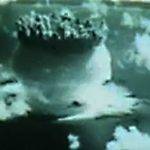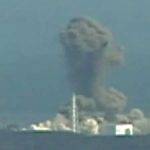The Hiroshima-Fukushima Connection
Lessons of Fukushima Conference San Francisco State University
Keynote
On Dec. 3, 2011, a ‘Lessons of Fukushima’ Conference was held at San Francisco State University.
The keynote speaker, was Dr. Anthony J. Hall, Professor of Globalization Studies at the University of Lethbridge, Alberta, Canada. He is the author of the recent article From Hiroshima to Fukushima, 1945-2011: A Nuclear Narrative of Hubris and Tragedy, Mr. Hall describes how the US introduced nuclear power into Japan and manipulates the media message. Hall’s book called Earth into Property (McGill/Queens University Press, 2010) describes the disastrous effects of capitalism on indigenous peoples.
He was introduced by conference organizer Steve Zeltzer, Director of the Labor Video Project and a producer and host on KPFA Radio, Steve is on the steering committee of the annual month long SF Labor Fest and is a member of the No Nukes Action Committee. He recently spent 3 weeks in Japan working on a documentary on the Fukushima nuclear disaster.
Also included below are excerpts from and links to Hall’s seminal article, plus two more articles by Yoichi Shimatsu, Former Editor of The Japan Times Weekly, on the history of the U.S. role in nuclearizing Japan. [ Thanks to Barbara George of Womens Energy Matters.org.]
To view on YouTube click here.

From Hiroshima to Fukushima, 1945-2011: A Nuclear Narrative of Hubris and Tragedy
by Anthony J. Hall, Professor of Globalization Studies University of Lethbridge
(28 March, 2011, Version 2, Running Draft)
The Nuclear Disaster at Fukushima Nuclear Plant Number One
From Hiroshima and Nagasaki in 1945 to the witches brew of melting, spewing and exploding nuclear matter at Fukushima Nuclear Power Plant Number One, the history of humanity’s first decades of encounter with energy’s atomic sources is unfolding as a poetic saga of hubris and tragedy.
In 2011 as in 1945, the people of Japan have been put at the centre of a dark science experiment testing the limits of human capacities to absorb new frontiers of nuclear devastation.
The tsunami of annihilation and then slow, radiation-induced sicknesses and deformities was introduced to the world with the terrible blasts of the two American Atomic bombs at Hiroshima and Nagasaki. Fate Man and Little Boy were the codenames bestowed by the US Air Force on the two original atomic bombs that were dropped on the two defenseless Japanese cities from the Boeing B-29 Superfortress named the Enola Gay.
Hundreds of thousands of tons of highly-radioactive spent nuclear fuel rods are stored at nuclear power stations in Japan, USA and most other nuclearized countries. This form of nuclear waste remains highly toxic for hundreds of thousands of years
The devastation wrought at Hiroshima and Nagasaki may prove limited compared to the catastrophe now set in motion at the maimed power station just north of Tokyo. The devastation underway has such enormous destructive potential because the site of Fukushima Daiichi (which translates from Japanese as “Fukushima Power Plant Number One”) has long been made to double as a massive storage facility for spent nuclear fuel rods, the most deadly and volatile form of nuclear waste. Read more.
Is Japan’s Elite Hiding a Weapons Program Inside Nuclear Plants?
New America Media, News Analysis,
Yoichi Shimatsu, Former Editor of The Japan Times Weekly
Posted: Apr 06, 2011
…The Manchurian Deal
The chain of events behind this vast fabrication goes back many decades.
During the Japanese militarist occupation of northeast China in the 1930s, the puppet state of Manchukuo was carved out as a fully modern economic powerhouse to support overpopulated Japan and its military machine. A high-ranking economic planner named Nobusuke Kishi worked closely with then commander of the occupying Kanto division, known to the Chinese as the Kwantung Army, General Hideki Tojo.
Close ties between the military and colonial economists led to stunning technological achievements, including the prototype of a bullet train (or Shinkansen) and inception of Japan’s atomic bomb project in northern Korea. When Tojo became Japan’s wartime prime minister, Kishi served as his minister of commerce and economy, planning for total war on a global scale.
After Japan’s defeat in 1945, both Tojo and Kishi were found guilty as Class-A war criminals, but Kishi evaded the gallows for reasons unknown—probably his usefulness to a war-ravaged nation. The scrawny economist’s conception of a centrally managed economy provided the blueprint for MITI (Ministry of International Trade and Industry), the predecessor of METI, which created the economic miracle that transformed postwar Japan into an economic superpower.
After clawing his way into the good graces of Cold Warrior John Foster Dulles, Eisenhower’s secretary of state, Kishi was elected prime minister in 1957. His protégé Yasuhiro Nakasone, the former naval officer and future prime minister, spearheaded Japan’s campaign to become a nuclear power under the cover of the Atomic Energy Basic Law.
American Complicity
Kishi secretly negotiated a deal with the White House to permit the U.S. military to store atomic bombs in Okinawa and Atsugi naval air station outside Tokyo. (Marine corporal Lee Harvey Oswald served as a guard inside Atsugi’s underground warhead armory.) In exchange, the U.S. gave the nod for Japan to pursue a “civilian” nuclear program.
Secret diplomacy was required due to the overwhelming sentiment of the Japanese public against nuclear power in the wake of the Hiroshima and Nagasaki atomic bombings. Two years ago, a text of the secret agreement was unearthed by Katsuya Okada, foreign minister in the cabinet of the first Democratic Party prime minister, Yukio Hatoyama (who served for nine months from 2009-10).
Many key details were missing from this document, which had been locked inside the Foreign Ministry archives. Retired veteran diplomat Kazuhiko Togo disclosed that the more sensitive matters were contained in brief side letters, some of which were kept in a mansion frequented by Kishi’s half-brother, the late Prime Minister Eisaku Sato (who served from 1964-72). Those most important diplomatic notes, Togo added, were removed and subsequently disappeared.
These revelations were considered a major issue in Japan, yet were largely ignored by the Western media. With the Fukushima nuclear plant going up in smoke, the world is now paying the price of that journalistic neglect. Read more.
The Next Nagasaki – Nuclear Fears Stalk The World
Threat to the American Public
by Yoichi Shimatsu
A second Hiroshima is happening with the partial meltdowns at Fukushima 1 nuclear reactors. We can only hope the eventual toll in lives comes nowhere near close to that of the world’s first atomic catastrophe.
The international community is now asking: Where will be the next Nagasaki?
In the US with its 23 aging reactors of identical design as Fukushima’s GE Mark 1 reactors, along with another dozen more of slightly modified design?
In France, the world’s most nuclear-dependent country?
Probably not in Germany or Venezuela, which are cutting back their nuclear programs, nor Britain, the world leader in conversion to offshore wind power. Or even China, a solar-energy paragon now scaling back plans for new nuclear plants.
Many people are also wondering: How can the only nation that ever experienced atomic bombings become so trusting in nuclear energy? The answer is both simple and complicated. In the modern economy, the energy to run machines is intertwined with national security, foreign policy and warfare. Read more.
=======
To help keep EON’s work going, please check out all the support options on our Donation Page or you can also send a check made out to EON to EON, POB 1047, Bolinas, CA
Or…just:




